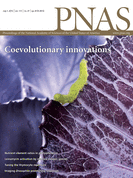PNAS封面文章:“蝴蝶”与“植物”的基因组复制“军备竞赛”

本期PNAS封面:图为一只在欧洲红卷心菜(甘蓝)喂养着的粉蝶毛虫(菜粉蝶)。Patrick P. Edger等人发现甘蓝植物家族的成员与毛虫之间长期的“军备竞赛”的多个关键进化点,例如近9000万年前芥菜植物发展芥子油苷的化学防御,这些关键创新点都跟基因和基因组复制有关。进一步,作者发现,植物化学防御的起源和毛虫的逆适应与转移到物种的生物多样性比例变化有关。作者表示这个实验结果表明,基因组复制和进化过程之间的联系。 本研究揭示的一个古老的蝴蝶和植物之间的军备竞赛机制,演化到今天看到无数花园卷心菜蝴蝶的幼虫吃白菜作物。近9000万年前,芸苔属植物的祖先(芥茉、卷心菜)和相关植物开发了一个名为硫配糖体的化学防御。这对大多数的昆虫是有毒的,但是人类对芥子油苷的化学防御的感觉就是尝起来像芥末的辛辣味,辣根和芥末。在文章里面指示出这引发了一个化学武器竞赛的触发器,并随着时间的推移不断升级的复杂性。通过调查这些植物和昆虫的进化历史,我们发现植物的化学防御的复杂性增加,紧跟着蝴蝶就会进行对抗牵引进化以便他们可以继续攻击植物并以植物为食。
原文链接:
The butterfly plant arms-race escalated by GENE and genome duplications
原文摘要:
Coevolutionary interactions are thought to have spurred the evolution of key innovations and driven the diversification of much of life on Earth. However, the genetic and evolutionary basis of the innovations that facilitate such interactions remains poorly understood. We examined the coevolutionary interactions between plants (Brassicales) and butterflies (Pieridae), and uncovered evidence for an escalating evolutionary arms-race. Although gradual changes in trait complexity appear to have been facilitated by allelic turnover, key innovations are associated with gene and genome duplications. Furthermore, we show that the origins of both chemical defenses and of molecular counter adaptations were associated with shifts in diversification rates during the arms-race. These findings provide an important connection between the origins of biodiversity, coevolution, and the role of gene and genome duplications as a substrate for novel traits.
doi: 10.1073/pnas.1503926112
作者:Patrick P. Edger

